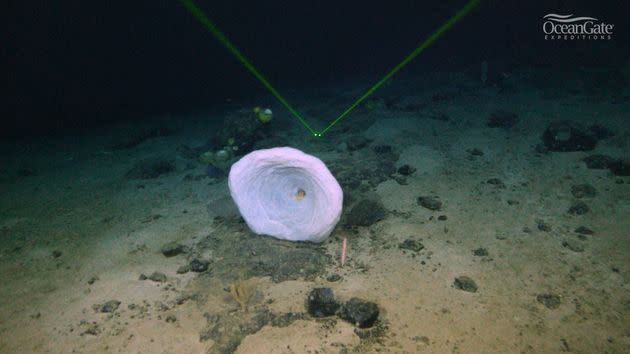Mysterious 'large object' detected near Titanic wreck finally identified

An unexpected sonar “blip” first detected in 1998 near the wreck of the Titanic has finally been identified.
“We didn’t know what we would discover,” veteran explorer PH Nargeolet, who first spotted the blip, said in a news release. “On the sonar, this could have been any number of things including the potential of it being another shipwreck. I’ve been seeking the chance to explore this large object that appeared on sonar so long ago.”
OceanGate Expeditions has been sending crews in a submersible to document the condition of Titanic since last year. During one of this year’s trips, a team that included Nargeolet ― who has been diving to the site for some 30 years ― checked out the anomaly near the legendary wreck.
As the video above shows, it was not another shipwreck. Instead, the team discovered an unexpected volcanic formation at a depth of 2,900 meters (9,514 feet) that Nargeolet said was “teeming with so much life.”
OceanGate is calling it the Nargeolet-Fanning Ridge, named for the veteran diver and mission specialist Oisín Fanning.

A detail from the Nargeolet-Fanning Ridge, near the wreck of the Titanic. (Photo: OceanGate)
“We are astonished at the diversity and density of the sponges, bamboo corals, other cold-water corals, squat lobsters and fishes that are thriving at 2900 meters deep in the North Atlantic Ocean,” OceanGate Expeditions chief scientist Dr. Steve W. Ross said in a news release.
Ross, who is also a research professor at the University of North Carolina Wilmington’s Center for Marine Science, added: “Uncovering this previously unknown ecosystem also provides an opportunity to make a comparison to the marine biology on and around Titanic.”
The life found on this natural reef may differ from what is now thriving on the nearby artificial reef that Titanic has become.

A detail from the Nargeolet-Fanning Ridge, near the wreck of the Titanic. (Photo: OceanGate Expeditions)
Earlier this year, OceanGate released the first-ever 8K footage from Titanic, showing the wreck to be deteriorating.
Along with bringing scientists into the deep, OceanGate offers spots on its expeditions to high-rolling adventure travelers. Seats as a “mission specialist” for next year’s trips to Titanic start at $250,000.
The company has also given spots to the Make-A-Wish Foundation.

A detail from the Nargeolet-Fanning Ridge, near the wreck of the Titanic. (Photo: OceanGate Expeditions)
This article originally appeared on HuffPost and has been updated.


